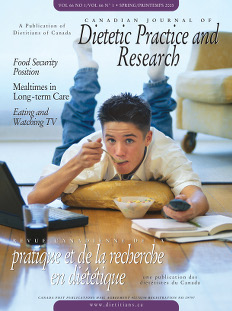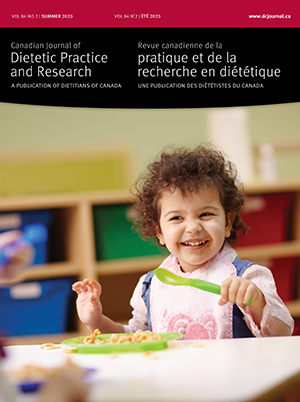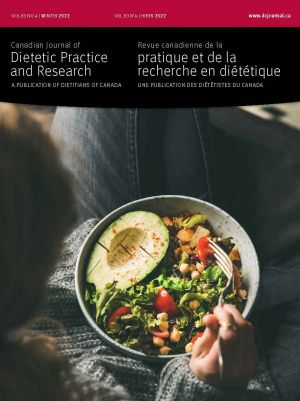Volume 66 • Number 1 • March 2005
Chair’s Message
Editor’s Message
Research
Mealtimes are central to the nutritional care of residents in long-term care facilities. There has been little Canadian research to guide interdisciplinary practice around mealtimes. This study included a grounded theory approach to explore mealtime experiences of 20 people with dementia living in two long-term care facilities, and the meal-related care they received from registered nurses, health care aides, and dietitians. Theoretical sampling directed the collection and analysis of data from mealtime observations in special care units and key informant interviews with care providers. The constant comparison method was used to analyze and conceptualize the data. A substantive theory emerged with three key themes: Each mealtime is a unique process embedded within a long-term care facility's environment. Residents are central to the process through their actions (i.e., arriving, eating, waiting, socializing, leaving, and miscellaneous distracted activities). Internal (i.e., residents’ characteristics) and external (i.e., co-resident, direct caregiving, indirect caregiving, administrative, and government activities) influences affect residents’ actions at mealtimes. The theory suggests that optimal mealtime experiences for residents require individualized care that reflects interdisciplinary, multi-level interventions.
To assess children's food-related behaviours and their relationships with eating while watching television (TV), data were collected from 534 ten-year-old French-Canadian children. A self-administered questionnaire was used. Almost 18% of girls and over 25% of boys reported eating in front of the TV every day. Although, overall, the boys’ eating pattern was less healthy than the girls’, all of the children's food choices deteriorated with increased frequency of eating in front of the TV. Compared with girls, boys gave more importance to coloured and attractive foods, and to selecting foods similar to those eaten by others. Over 50% of children reported always receiving negative weight-related comments from family members. For boys, significant correlations were found between the frequency of eating in front of the TV, the importance given to a food's appearance, and their requests to parents for advertised foods. Significance was at the p<0.05 level for all findings. These results suggest that gender should be considered in attempts to understand children's food motivations and behaviours. The findings also indicate the need to document children's eating environments, and to inform children and their families about eating behaviours that may be associated with a given environment.
Chronic malnutrition and growth failure are frequent consequences of feeding difficulties in neurodevelopmentally disabled children. Gastrostomy feeding has been used successfully to alleviate chronic malnutrition as well as distress and frustration associated with feeding. Unfortunately, caregivers are often resistant to gastrostomy placement. In order to determine the impact of gastrostomies in 20 children with neurodevelopmental disability (NDD), a questionnaire was used to collect caregivers’ perceptions both before and after gastrostomy. The questionnaire assessed caregivers’ retrospective perceptions of quality of life, feeding difficulties, and the burdens and benefits of gastrostomies. To determine impact on growth, height and weight were measured once before and three times after gastrostomy (at six, 12, and 24 months). The number of times a child was fed and the amount of time spent feeding decreased significantly following gastrostomy (p<0.001 and p<0.05, respectively). Growth for all children improved following gastrostomy (p<0.001). Pregastrostomy problems improved significantly following gastrostomy, as did caregivers’ perceptions of quality of life for both themselves and their child (p<0.001). These results indicate that gastrostomy has a positive impact on growth for neurodevelopmentally disabled children, and on quality of life for both children and caregivers. Caregivers may find these results encouraging if they are faced with a decision about gastrostomy placement for their child.
To identify barriers to following calcium recommendations among women with reduced bone mineral density (BMD), four focus group sessions were held with 30 postmenopausal women diagnosed with low BMD. Key concepts and themes were derived from transcripts. Participants were aware of the importance of calcium to their bone health, and were attempting to follow calcium intake recommendations. Several major themes associated with the ability to obtain adequate calcium were identified, including knowledge and confidence in actions, lifestyle and food preferences, and side effects and conflict with other health conditions. Participants reported that they obtained information in an effort to make a confident decision about calcium intake, but were easily confused by conflicting information. Daily routines and family and personal food preferences influenced dietary behaviours. Women indicated that side effects, particularly those associated with perceived lactose intolerance, caused them to restrict their calcium intake. Our data provide important insight into factors that women believe affect their ability to reach recommended calcium intakes. To optimize osteoporosis prevention and treatment, dietitians should focus on individualized patient assessments to identify factors affecting adherence to dietary calcium recommendations.
Review
The mass media, including broadcast, electronic, and print media, have become entrenched in Canadians’ daily lives. Spending the majority of their leisure time with mass media puts Canadians at increased health risk. Our review of the research literature shows that television (TV) viewing and content are linked to potential consumer health risks due to developed health attitudes, beliefs, and behaviours. The associated health risks of children and youth are of particular concern. Excessive TV viewing has been associated with obesity development, increased energy consumption, reduced energy expenditure, negative body image development, and reduced concern with the concept of self-care. Media literacy, the ability to view critically and understand mediated messages, is a possible technique to mitigate these adverse effects. The enhanced inclusion of media literacy concepts in health education activities of dietetic practice is advocated. Dietitians could increase their understanding of research findings on the health-related effects of mass media use and the implications of including media literacy in daily practice. Such awareness would further augment available health promotion strategies.
Report
Research indicates that the ability to perform a task can be affected by the composition of the meal preceding the task. This study investigated the effect of shift workers’ consumption of a medium-fat, medium-carbohydrate meal on alertness scores. Six subjects (four men, two women) aged 19 to 44 recorded food intake, sleep, and quality of sleep for two weeks, and measured their body temperature and performed cognitive tests during two night shifts at baseline and in test periods. The Stanford Sleepiness Scale (SSS) was used to quantify sleepiness, and a Paced Auditory Serial Addition Test (PASAT) was used to measure cognitive performance. In comparison with the score at baseline, when subjects had a low-fat, high-carbohydrate dietary intake (1,335 kcal/5,588 kJ, 56% carbohydrate, 28% fat), the 1.6-second PASAT score improved significantly (p=0.042) during night shifts when subjects consumed a test meal (987 kcal/4,131 kJ, 46% carbohydrate, 42% fat). No statistically significant difference in SSS was found between baseline and test periods. The reduced body temperature between 2400 hours and 0530 hours was similar for both baseline and test periods. Meal composition and size during night shifts may affect cognitive performance.
Public Policy Statement
The position of Dietitians of Canada (DC) is that all Canadians must have food security. Recognizing food security as a social determinant of health, DC recommends a population health approach to food security: that is, an approach that seeks to reduce health inequities through the pursuit of social justice. A population health approach addresses the root cause of individual and household food insecurity – poverty – through improvements to the social safety net. DC strongly encourages dietitians to educate themselves about the issues and processes to achieve food security through social change, to use empowering strategies in community-based food programming, to conduct and apply research, and to participate in coalitions that advocate to create the conditions in which all Canadians can achieve food security.










